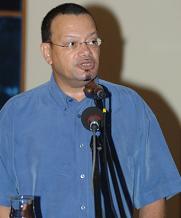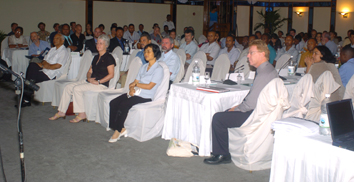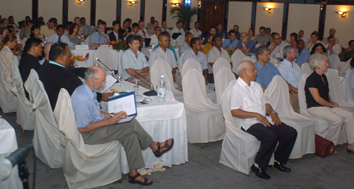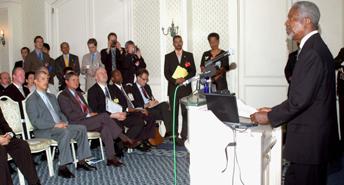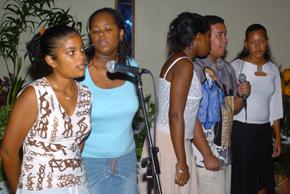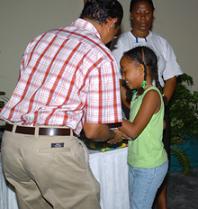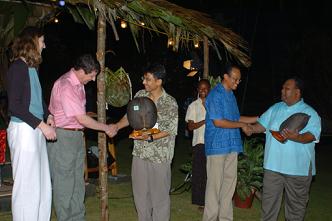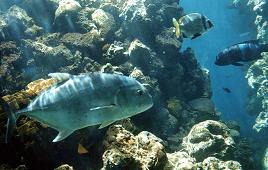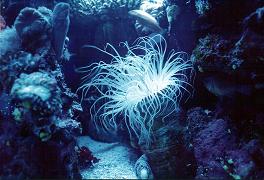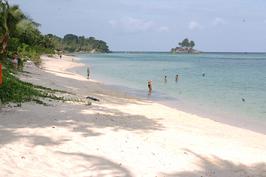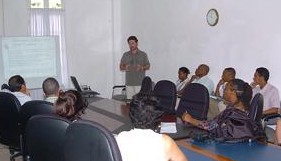From Ramsar Website: February 2nd 2005.
Introduction:
To celebrate this year's theme of "There is wealth in Wetland Diversity, Don't lose it" the Wetland Unit of the Ministry of Environment and Natural Resources (MENR) decided to sponsor various activities for schoolchildren.
The highlight was a 'hike' to one of the high altitude wetland sites on the main island of Mahe. Similar 'field trips' were organised for the schoolchildren on the Islands of Praslin and La Digue on the same day. The respective wetland teams with the aid of the Environment focal points on the islands, conducted field trips to wetland areas with the school children.
Objective:
As our school children are the future environment managers, it was felt that a guided tour to the wetland site would be a most appropriate way to sensitise and educate the students on the theme of this year's wetland day, in other words to experience first hand the "wealth of our wetlands". The 56 students who participated were from various secondary schools on Mahe, Praslin and La Digue islands.
Proceedings:
The Director General of Policy Planning and Services Division (PPS), Mr Francis Bijoux, officially marked the World Wetland Day with an opening ceremony in the morning of the 2nd February, in the presence of the Principal Secretary (PS) of Environment, Mr Rolph Payet.

Participants assemblage at the PPS Head Quarters.
Mr Bijoux highlighted the importance of protecting our wetlands, in order to safeguard the "wealth" of the biodiversity, knowledge and resources that it provides. He made special mention to our recent accession to the convention and how it will be in force by March 25th of this year. This development will greatly help in our aim to conserve and better manage the wetlands, including the role they play and important functions they provide.
The Ministry of Education and Youth, through the Education and Information Section of the Environment Department assisted the Wetland Unit in coordinating the event with the responsible persons at the Secondary Schools. Each school was invited to send 2 students.
All Wetland Unit staff (on the three islands) participated in the activities, with Mr France Sophola (Wetland Supervisor) and Dr. Pugazhendhi Murugaiyan (Senior Wetland Officer) coordinating the day's event.
Other staff from the Policy Planning and Services Division (PPS) also participated in the 'hike' to Mare Cochon; including staff from the Coastal Zone Unit, International Conventions Unit, Forestry and Conservation Sections, were able to offer advice and encouragement along the way. Two qualified rangers from the Forestry office of the Morne Seychellois National Park; Mr. Roy Youpa, and Mr. Terence Valentine guided the 'hiking party'.

Mr Roy Youpa, Ranger (first left) with students of the 'hiking party'
The media were also present at the opening ceremony and from invitation; Mr Nick Watson, a journalist from the Seychelles Nation (national newspaper) also participated in the 'hike'.
Activities on Mahe;
Getting started for the Mare Cochon Hike:
The Mare Cochon wetland is found in the Morne Seychellois National Park situated approximately 350m above seal level. The 'hike' was approximately 2hours along a trail that is maintained by the Forestry division of the Ministry of Environment and Natural Resources.

Mr France Sophola, Wetland Officer (first left hand corner) giving a brief talk on the safety rules and regulations to the students, before taking the hired bus to the start of the hike
Along the way:
The 'hiking party' of around 34 people was split into two groups, each headed by a guide.
Complimentary bottles of water were handed out to the students, with an activity booklet, which the students were asked to complete during the hike. Along the way the students were shown out the different types of flora and fauna, with emphasis on the 'endemics' of our islands. The students were able to 'tick off' most of these species in the activity booklet.
At Mare Aux Cochons:

Pristine view of the Mare Aux Cochons freshwater marsh at 350m high uphill
The Mare Aux Cochons Wetlands features a walkway through the marsh area towards a 'kiosk' (wooden station) where students rested. At this location Dr Murugaiyan (Senior Project officer) gave a small presentation on the roles of wetlands in our ecosystem, and stressed the importance of protecting and conserving them.
He explained how the Mare Aux Cochon, one of the three high altitudes wetlands of the Seychelles, was 'special' in that it is the only wetland to be found within a Protected Area; the Morne Seychellois National Park. Consequently the several endemic and indigenous species of plants and animals found there are always protected. It is therefore very important that other wetland areas are also protected in order to have the same 'wealth'; richness of biodiversity and a respected natural resource.
It was also explained how the Mare Aux Cochon wetland area is the main supply of freshwater, with streams running from the site towards one of the main rivers on the island. The water also reaches the Port Glaud - Port Launay wetland area, which as mentioned before, is the first International RAMSAR Wetland site for the Seychelles.
At the site, students were in for a surprise when a small quiz competition was organised to test their newly acquired knowledge on wetland plants and animals, and winners were distributed with prizes.
Activities on Praslin and La Digue:
This year, the Wetland Day Activities were also celebrated simultaneously with the islands of Praslin and La Digue. The respective wetland teams, with their team leaders and the assistance of the Environmental focal points, conducted field trips to main wetland areas with various school children on the two islands. Maintenance and 'clean up' activities of the wetland outlets were carried out with the students to demonstrate how it is done.
Handouts detailing the importance of wetlands conservation and management were distributed to them.
Media coverage of the World Wetland Day Activities:
As part of the celebration for the Wetland Day, quizzes and crossword puzzle competitions were organised. The competitions features the theme of wetland conservation were published in the Seychelles Nation (local newspaper) and aired on the AM radio. Winners of the different competitions were awarded with their prizes.
Conclusion:

All participants at the Mare Aux Cochons wetland site.
The activities for the commemoration of World Wetland Day were a great success given that this year's events were limited in number and size (in comparison to previous years) due to the recent events in the South-Eastern area. However, the students actively engaged in the day's events. They expressed interest and appreciation of the Wetland areas. As a result, it has been concluded that more sensitisation trips on wetlands, especially with school children is necessary. The wetland Unit has noted that more of such activities must be organised during the year and included in future work plans.
Acknowledgement:
The Wetland Unit of the Policy Planning and Services Division would like to thank the staff at;
Policy Planning and Services Division;
National Parks & Nature Conservancy;
Forestry Section;
Education and Information section;
Would also like to thank the:
Ministry of Education and Youth,
Seychelles Nation
Seychelles Broadcasting Cooperation
Our sponsors are:
AirTel (Telecommunication)
Mr. Francis Esparon (Contractor)
Mr. Andy Ah-Kon (Contractor)
Mr. Laporte - (Contractor)
"There's wealth in wetland diversity
- don't lose it!"




